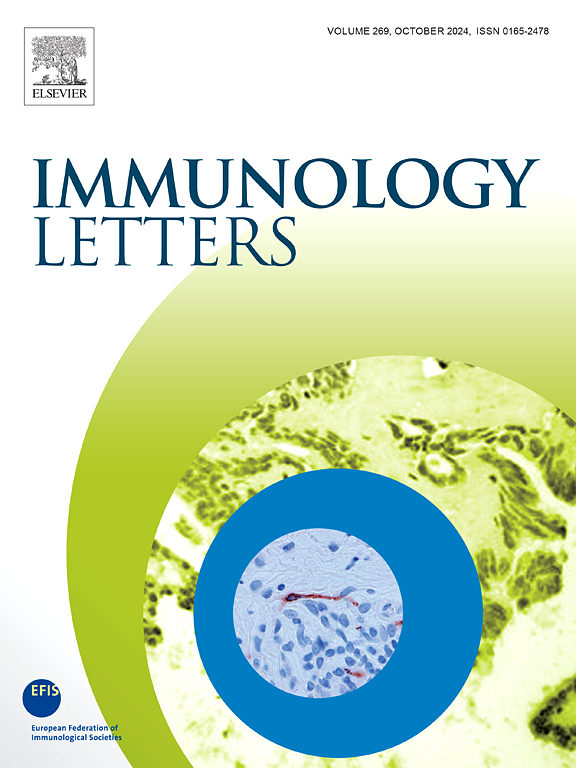α2-肾上腺素受体激动剂氯尼丁通过Nrf2/NF-κB信号通路保护新生小鼠免受缺氧缺血性脑损伤。
IF 2.8
4区 医学
Q3 IMMUNOLOGY
引用次数: 0
摘要
新生儿缺氧缺血性脑损伤(HIBD)是一种与神经炎症和氧化应激密切相关的严重疾病。氯尼定是一种选择性α2肾上腺素能受体激动剂,以其抗炎和抗氧化特性而闻名。尽管氯尼丁具有这些公认的治疗功效,但其对 HIBD 发挥作用的确切机制尚未完全明了。本研究旨在深入研究氯尼丁对 HIBD 诱导的神经元损伤的影响,并阐明其潜在的作用机制。我们采用新生小鼠 HIBD 模型,仔细评估了氯尼丁对神经元损伤、细胞凋亡、炎症和氧化应激标志物的影响。此外,我们还进行了广泛的体外研究,利用细胞计数试剂盒-8(CCK-8)、流式细胞术、酶联免疫吸附试验(ELISA)、免疫荧光试验和免疫印迹等先进技术,评估了氯尼丁对原代海马神经元细胞的神经保护作用。此外,我们还通过体内和体外实验,探讨了氯尼定对核因子红细胞2相关因子(Nrf2)/核因子κB(NF-κB)信号通路的调控作用。结果表明,氯尼地平能明显减轻 HIBD 小鼠的脑梗塞、神经元损伤和细胞凋亡。它还缓解了神经炎症和氧化应激,提高了细胞存活率,减少了氧-葡萄糖剥夺/复氧(OGD/R)对神经元的损伤。氯尼定的神经保护作用与激活 Nrf2/血红素加氧酶-1(HO-1)通路和抑制 NF-κB 通路有关。总之,氯尼地定可能通过调节Nrf2/NF-κB信号通路,减少神经炎症和氧化应激,从而对HIBD表现出神经保护作用。本文章由计算机程序翻译,如有差异,请以英文原文为准。
The alpha2-adrenoceptor agonist clonidine protects against hypoxic-ischemic brain damage in neonatal mice through the Nrf2/NF-κB signaling pathway
Neonatal hypoxic-ischemic brain damage (HIBD) is a severe condition closely associated with neuroinflammation and oxidative stress. Clonidine, a selective α2-adrenergic receptor agonist, is known for its anti-inflammatory and antioxidant properties. Despite these recognized therapeutic benefits, the exact mechanisms by which clonidine exerts its effects in the context of HIBD are not fully understood. This study was designed to thoroughly investigate the impact of clonidine on HIBD-induced neuronal injury and to clarify its underlying mechanism of action. We employed a neonatal mouse model of HIBD to meticulously assess the effects of clonidine on neuronal injury, apoptosis, inflammation, and oxidative stress markers. In addition, we conducted extensive in vitro studies to evaluate the neuroprotective effects of clonidine on primary hippocampal neuronal cells, utilizing advanced techniques such as the Cell Counting Kit-8 (CCK-8), flow cytometry, enzyme-linked immunosorbent assay (ELISA), immunofluorescence assay, and western blotting. Furthermore, we explored the regulatory effects of clonidine on the nuclear factor erythroid 2-related factor (Nrf2)/nuclear factor-κB (NF-κB) signaling pathway through a combination of in vivo and in vitro experiments. The results showed that clonidine significantly reduced cerebral infarction, neuronal damage, and apoptosis in HIBD mice. It also alleviated neuroinflammation and oxidative stress, improved cell viability, and reduced neuronal injury following oxygen-glucose deprivation/reoxygenation (OGD/R). The neuroprotective effects of clonidine were linked to the activation of the Nrf2/heme oxygenase-1 (HO-1) pathway and the inhibition of the NF-κB pathway. Overall, clonidine exhibited neuroprotective properties in HIBD by reducing neuroinflammation and oxidative stress, likely through the modulation of the Nrf2/NF-κB signaling pathway.
求助全文
通过发布文献求助,成功后即可免费获取论文全文。
去求助
来源期刊

Immunology letters
医学-免疫学
CiteScore
7.60
自引率
0.00%
发文量
86
审稿时长
44 days
期刊介绍:
Immunology Letters provides a vehicle for the speedy publication of experimental papers, (mini)Reviews and Letters to the Editor addressing all aspects of molecular and cellular immunology. The essential criteria for publication will be clarity, experimental soundness and novelty. Results contradictory to current accepted thinking or ideas divergent from actual dogmas will be considered for publication provided that they are based on solid experimental findings.
Preference will be given to papers of immediate importance to other investigators, either by their experimental data, new ideas or new methodology. Scientific correspondence to the Editor-in-Chief related to the published papers may also be accepted provided that they are short and scientifically relevant to the papers mentioned, in order to provide a continuing forum for discussion.
 求助内容:
求助内容: 应助结果提醒方式:
应助结果提醒方式:


